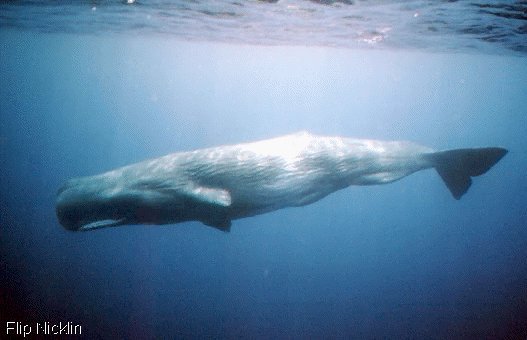
Sperm whales, found in most oceans, get their name from the oily
fat-called spermaceti-contained in their large heads. Diving deep in search
of squid, sperm whales may remain submerged for as long as an hour
Classification
Sperm Whale, largest of the toothed whales make up the family Physeteridae
of the suborder Odontoceti, order Cetacea. It is classified as Physeter
catodon. The Pygmy Sperm whale is classified as Kogia breviceps, and the
Dwarf Sperm whale as Kogia simus.
Appearance
Sperm whales have a huge head—up to one-third the length of the body—which
houses the spermaceti, a light oily fat that is believed to aid the animal
in sending a directional beam of echolocation clicks from its snout. Below
the head is a relatively small and thin lower jaw, which contains a set
of cone-shaped teeth that fit into sockets in the upper jaw. The bodies
of sperm whales are laterally compressed, with a single blowhole on the
left front of the head and a thick dorsal hump originating at the hindmost
third of the body. There is a section of distinctive wrinkled skin behind
the head. The body is dark gray or black, but the lips are white and there
are whitish spots on the belly. There is a large difference in size between
the sexes, with mature females growing to about 12 m in length, and mature
males growing to about 18 m.
Diet
Sperm whales feed on fishes and particularly on large deep-water squid.
According to one hypothesis, the loudest of their vocalizations, sharp
clicks, may be loud enough to stun their prey and thereby facilitate feeding.
Behavior
The whales routinely dive deeper than 1 km (deeper than 0.6 mi.)
while feeding on squid, and they commonly remain submerged for 45 to 60
minutes at a time. After a long dive, sperm whales must stay at the surface
for about 12 to 15 minutes, respiring (blowing) constantly to replenish
their oxygen stores. Sperm whales generally travel in groups of mixed species
composed of adult females with sub-adults and calves of both sexes. These
groups can be as large as 50 individuals, but they usually include only
about 12 animals. However, because the clicks that the whales use to communicate
can be heard for at least 10 km (at least 6 mi.), the social unit may actually
consist of several groups in an area that keep in touch through sound.
Their communication includes a different sequence of clicks, or coda, for
each individual, and it is likely that these distinctive codas are a means
by which individuals recognize one another.
Breeding
Adult males usually travel in all-male groups or, more rarely, alone,
joining the female-based groups for short periods in order to mate. Large
males probably compete with one another for access to female groups, and
females may choose particular males, probably on the basis of size. Gestation
of the single young takes 15 to 16 months—probably the longest gestation
period for any cetacean. Nursing can last for several years while the calf
grows and learns to hunt.

Sperm whales, found in most oceans, get their name from the oily
fat-called spermaceti-contained in their large heads. Diving deep in search
of squid, sperm whales may remain submerged for as long as an hour
.